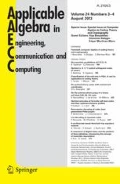Abstract
“Mirror Theory” is the theory that evaluates the number of solutions of affine systems of equalities \(({=})\) and non equalities (\(\ne \)) in finite groups. It is deeply related to the security and attacks of many generic cryptographic secret key schemes, for example random Feistel schemes (balanced or unbalanced), Misty schemes, Xor of two pseudo-random bijections to generate a pseudo-random function etc. In this paper we will assume that the groups are abelian. Most of time in cryptography the group is \(((\mathbb {Z}/2\mathbb {Z})^n, \oplus )\) and we will concentrate this paper on these cases. We will present here general definitions, some theorems, and many examples and computer simulations.

Similar content being viewed by others
References
Hall Jr., M.: A combinatorial problem on abelian groups. Proc. Am. Math. Soc. 3(4), 584–587 (1952)
Patarin, J.: Security of random Feistel schemes with 5 or more rounds. In: Proceedings of Advances in Cryptology—CRYPTO 2004, 24th Annual International Cryptology Conference, Santa Barbara, CA, August 15–19, 2004, pp. 106–122 (2004)
Patarin, J.: On linear systems of equations with distinct variables and small block size. In: 8th International Conference on Information Security and Cryptology—ICISC 2005, Seoul, December 1–2, 2005, Revised Selected Papers, pp. 299–321 (2005)
Patarin, J.: The “coefficients H” technique. In: 15th International Workshop on Selected Areas in Cryptography, SAC 2008, Sackville, New Brunswick, August 14–15, Revised Selected Papers, pp. 328–345 (2008)
Patarin, J.: A proof of security in O(2\({}^{\text{n}}\)) for the Xor of two random permutations. In: Proceedings of Third International Conference on Information Theoretic Security, ICITS 2008, Calgary, August 10–13, 2008, pp. 232–248 (2008)
Patarin, J.: A proof of security in O(2\({}^{\text{ n }}\)) for the Xor of two random permutations\(\backslash \backslash \) -proof with the \({H}_\sigma \) technique-. IACR Cryptol. ePrint Arch. 2008, 10 (2008)
Patarin, J.: Introduction to mirror theory: analysis of systems of linear equalities and linear non equalities for cryptography. IACR Cryptol. ePrint Arch. 2010, 287 (2010)
Patarin, J.: Security of balanced and unbalanced Feistel schemes with linear non equalities. IACR Cryptol. ePrint Arch. 2010, 293 (2010)
Patarin, J.: Security in O(2\({}^{\text{ n }}\)) for the xor of two random permutationsproof with the standard H technique. IACR Cryptol. ePrint Arch. 2013, 368 (2013)
Salzborn, F., Szekeres, G.: A problem in combinatorial group theory. Ars Comb. 7, 3–5 (1979)
Acknowledgements
I would like to give many thanks to an anonymous referee of AAECC. Thanks to his/her remarks, I was able to improve this paper on many points.
Author information
Authors and Affiliations
Corresponding author
Rights and permissions
About this article
Cite this article
Patarin, J. Mirror theory and cryptography. AAECC 28, 321–338 (2017). https://doi.org/10.1007/s00200-017-0326-y
Received:
Revised:
Accepted:
Published:
Issue Date:
DOI: https://doi.org/10.1007/s00200-017-0326-y




